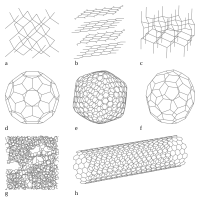
Photo from wikipedia
Porous carbon sphere materials have a large variety of applications in several fields due to the large surface area, adaptable porosity, and good conductivity they possess. Obtaining a steady carbon… Click to show full abstract
Porous carbon sphere materials have a large variety of applications in several fields due to the large surface area, adaptable porosity, and good conductivity they possess. Obtaining a steady carbon sphere using the green synthesis method remains a significant challenge. In this experiment, covalent organic frameworks (COFs) were used as a precursor and Fe3O4NPs were integrated into the precursor in order to synthesize a porous carbon sphere material using the one-step pyrolysis method. COFs have an ordered porous structure, perpetual porosity, large surface area, and low density and display good environmental tolerance. These properties make them an excellent precursor for synthesizing porous carbon sphere, which maintains good morphology at high temperatures, and it is not involved in the removal of dangerous reagent and small size restrictions during the synthesis process. In addition to the formation of a porous carbon sphere, transition metal carbon material that contains N element can be an active catalyst. The composites exhibit better activity when Fe is doped into carbon materials containing N element than that of other doped transition metals including Mn and Co. In this situation, the integration of Fe3O4NPs and N element in the COF precursor exposed the active sites of the composites and the two substances synergistically improved the electrocatalytic properties, and the composites were named Fe3O4@NPCS. The constructed Fe3O4@NPCS/GCE immunosensor was applied as a means of detecting CA19-9 antigen and presented a wide linear range from 0.00001 to 10 U/mL with a low detection limit of 2.429 μU/mL (S/N = 3). In addition, the prepared immunosensor was utilized for detecting CA19-9 antigen in the real human serum, and the recovery rates were in the range from 95.24% to 106.38%. Therefore, a porous carbon sphere prepared by COFs as a precursor can be applied for the detection of CA19-9 antigen in real samples, which could be an excellent strategy for CA19-9 antigen detection and could potentially promote the development of COF materials in various electrochemical fields.
Journal Title: Applied Biochemistry and Biotechnology
Year Published: 2022
Link to full text (if available)
Share on Social Media: Sign Up to like & get
recommendations!